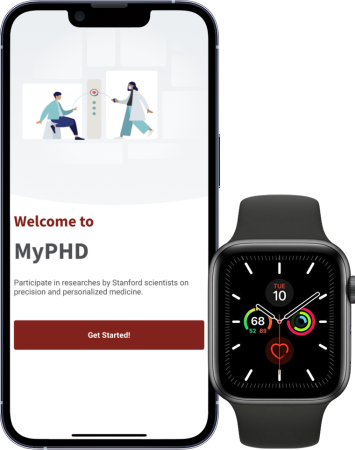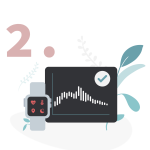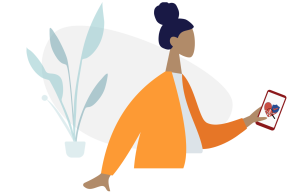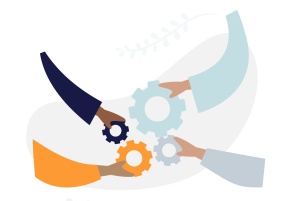Targeted Real-time Assessment of Chronic Pain (TRAC-Pain) in Youth Study
Sign up to participate in a 12-week long research study focused on addressing the significant issue of chronic musculoskeletal pain in teenagers and young adults, a condition affecting millions and often leading to long-term health issues.
Our study team plans to use Apple watches and surveys to monitor heart rate, sleep, activity and the pain experience. By analyzing this data with advanced technology, we hope to create a “digital biosignature” that gives a real-time, objective measure of the pain experience. This could help doctors choose better treatments and could improve the quality of life for young people suffering from chronic pain.
or download the MyPHD app to begin:
SECTION BELOW FOR MOBILE/TABLET ONLY
or download the MyPHD app to begin:
Who Should Join
We welcome you to join if you meet the following criteria:
- Are 14-24 years of age.
- Have pain in one or more body areas for three or more months.
- Own an Apple Watch or are willing to wear one for the duration of the study.
Prefer to enroll now, and download app later?

Who Should Join
We welcome you to join if you meet the following criteria:
- Are 14-24 years of age.
- Have pain in one or more body areas for three or more months.
- Own an Apple Watch or are willing to wear one for the duration of the study.

Prefer to enroll now, and download app later?
If you do not own a device, please email us at trac_pain_study@stanford.edu.
How It Works

Collect Data
Our goal is to use wearable devices to track pain changes before any big changes in symptoms happen.

Develop Algorithms
Together, we’ll build a tool that can spot changes in your usual patterns to help predict when pain might get worse.

Validate Algorithms
In the next part of the study, we’ll test our system to see if it can spot the changes in your usual patterns before the pain gets worse.
what you will do
1. Download the app and enroll.
Download an app, developed by Stanford University School of Medicine, that will allow us to collect data from your wearable device.

2. Wear device.
Wear your Apple Watch day and night to keep track of your health data.

3. Answer Surveys.
After enrollment, you will be asked to complete a baseline survey, brief daily surveys, and a discharge survey about you and your pain experience.

What we promise
A gold standard for safety
Our data collection app MyPHD was designed based on Stanford’s gold-standard of data privacy and security. Your data is safe with us.
Your data is secure
This study has been rigorously vetted and approved by the Stanford Institutional Review Board.
Stanford Medical Study Practices


Your contribution is valuable
Your data directly contributes two ends:
- Developing our change in pain experience detection system.
- Advancing the delivery of customized pain treatment interventions for future use
This could support a safer re-opening of the economy, since it would allow people to self-isolate as opposed to unwittingly spreading the disease when they are pre-symptomatic or asymptomatic.
You are in good company
We are proud to join forces with pain advocacy organizations like the US Pain Foundation and the American Chronic Pain Association to improve pain care for everyone.
We are here for you
Your participation is voluntary, and you have the right to withdraw your consent or discontinue participation at any time. If you have any questions, please visit our FAQ section below or reach out to us at trac_pain_study@stanford.edu. We are always happy to answer your questions.

Frequently asked questions
1. Participation Eligibility & Enrollment

How do I get enrolled in the study?
To see if you are eligible to enroll in this study, please follow this link and fill out the associated screening questionnaire. A member of our study team will review your responses and if you are eligible we will reach out to schedule a zoom meeting to discuss the study further.
Can my friend/spouse/family member enroll as well?
If they meet the eligibility criteria, they can enroll on this page.
Please do not provide the friend/spouse/family member’s contact details to us. For privacy reasons, we cannot reach out to them directly. Please ask them to visit this webpage to find out if they are eligible.
if they are eligible. Does this study enroll non-English speakers?
Currently, we can only enroll people who live in the USA and can consent in English. If you can read and understand the consent form in English, feel free to enroll if you are interested. We plan in the coming months to enroll Spanish-speaking individuals as well.
I’d like to participate but I don’t own an Apple watch. Can you provide me with one?
If you do not own an Apple watch but you are interested in participating, please reach out to our team at trac_pain_study@stanford.edu.
I forgot to enter some information in the enrollment survey. What should I do?
Please email us at trac_pain_study@stanford.edu and we can help sort everything out.
What is a pain flare?
A pain or symptom flare is a temporary but noticeable worsening of your usual pain and/or symptoms (like fatigue, stiffness, or emotional distress) that feels more intense than what you typically deal with. Here’s how to know if what you’re experiencing might be a flare:
- It’s Really Disruptive: The pain or symptoms feel strong enough to interfere with things you normally do, like going to school, exercising, or hanging out with friends.
- It Lasts Longer Than Usual Pain Spikes: A flare can stick around for hours, days, or even weeks, and you’ll likely notice a clear start and end to it (though it might fade slowly or suddenly).
- It Affects More Than Just Pain: A flare can make moving harder, leave you feeling more anxious, sad, or frustrated, and make it tougher to handle everyday challenges.
- It Might Be Linked to a Trigger (But Not Always): Things like pushing yourself physically, feeling stressed, changes in the weather, or being sick can sometimes set off a flare—but they can also happen without a clear reason.
- It’s Bigger Than Usual Pain Changes: Flares are more intense and last longer than the usual ups and downs of your pain. They’re not just part of your daily pain shifts; they’re a bigger deal.”
2. How to Participate & What to Do During The Study

What is the purpose of this research study?
This study focuses on improving how we understand and treat chronic musculoskeletal pain in teens and young adults. Current treatments don’t work well for everyone, and their effectiveness varies. In this study, we’re using wearable devices to track things like physical activity, sleep, and body signals. The goal is to use this information to better understand chronic musculoskeletal pain, develop new ways to prevent and treat it, and create tools that make clinical trials more effective and affordable.
Can I participate in the study without signing a research consent form or Authorization to Use Your Health Information For Research Purposes form?
No. Information about you and your health is personal and private, it cannot be used in this research study without your written authorization. Your information will only be used in accordance with this authorization form and the consent form and as required by law.
How long do I need to keep completing the surveys / sharing my wearables data?
We ask you to share your wearable data and complete surveys for 12 weeks. However, your participation in the study is entirely voluntary and you can withdraw from the study at any time.
What do I do during the study as a participant?
Taking part in the study will involve:
- Downloading an app, developed at Stanford University, that will allow us to collect the data from your wearable device;
- Continuously wearing your Apple Watch for 12-weeks up to 24 hours per day;
- Completing various surveys over the course of the 12-week study about your pain, fatigue, mood, sleep and activity;
- Completing a video recorded online stress task that involves giving a speech in front of an audience and doing some math. Additionally, you will be asked to complete a video recorded sit to stand exercise test.
- Answering questions about feasibility and usability.
I want to withdraw from the study. What should I do?
Contact our study team at trac_pain_study@stanford.edu and we can help you withdraw from the study.
3. Consent, Authorization & Data Privacy

4. Contacts for Questions, Concerns & Complaints



